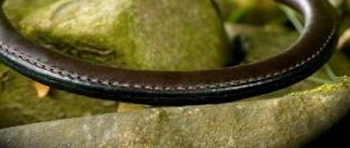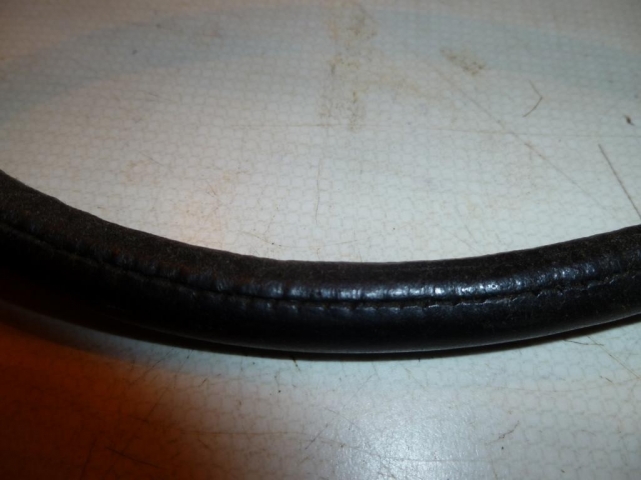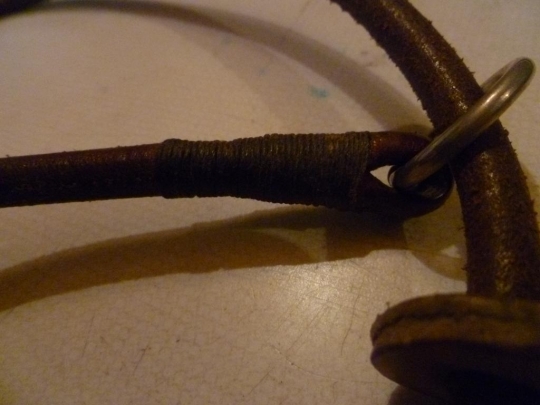CAN YOU TELL WHAT IS REAL ROLLED WORK, WHAT IS MADE BY HAND, WHAT IS MACHINED AND WHAT IS A COMPLETE FAKE?
I have seen lots of so called "rolled" leatherwork on internet auctions and websites recently which is not actually REAL handmade rolled work as
it's title implies.
For anyone who is thinking of buying a piece of quality rolled work whether a bridle or a dog lead/collar here are a few pointers to look out for.
IF you are happy with cheap and often nasty imitations then fine, this article won't concern you, if you want the real thing read on.
Importance of quality, not quantity
Traditional rolled work that is correctly made involves splitting the leather thickness down, adding a central round hard core and "rolling" the leather round to give it the shape. Then it should be hand stitched down one side, whilst leaving a generous amount of leather above the stitches to the edges of the leather.Then finally worked in a rounding block to turn the ends/edges of the leather backover the stitching to hide and protect it. The turns of leather round a fitting are the only parts where you will see the stitching.There's a LOT of work involved to make rolled leatherwork correctly. When finished and smoothed over with a bone and stain, along it's length you'll faintly see the edges of the leather but you won't see the stitches, this is proper top quality rolled work.
Most of the rolled work I am seeing you can see the stitching and by looking at the stitching I can tell you it's simply run through a sewing machine, the stitches don't last as long as hand stitched, no where near as long.
Technically this is rolled work of sorts but it is massed produced, incorrectly made, cheap and certainly NOT top quality as it's not carefully finished off. Even if it IS hand stitched down it's entire length the stitches still need to be hidden or it's only half finished.
If it hasn't got any central round core but merely folded in half and possily has webbing as it's core (but not always) and looks flat then it's folded leather NOT rolled work.
Top quality should include not only the materials to make the product but the techniques used to actually make it.
Handmade work in the saddlery and leatherwork trade will always be preferable over machined work of any kind as long as the craftsmen making it are suitably trained and not as I so often see, have read a book, self taught themselves after 2 weeks of reading and are suddenly experts with their work for sale slapped all over various social media sites, auction sites and forums.
Fake rolled work
I also seeing lots of ROUND LEATHER BELTING being passed off as rolled work. Round leather belting , which is, lengths of leather bonded and compressed together then shaped into a rounded form by a machine in the factory.I use it for a driving belt on my old circa 1915 treadle 45k sewing machine amongst other things, some time ago people started using this belting to make dog leads/collars even bridles but it stretches like mad. I made a slip lead out of it for my Lurcher as a training lead and used with a back up second lead on a harness. I would never use one on it's own, it's just not worth the risk. It's cheaper and far quicker to make using it but not as good or as strong as Traditional rolled work. The round leather belting as well as flat folded leather without any core will always break before proper rolled work does.
Traditional rolled work costs much more than machined rolled work or round leather belting because of the amount of labour involved so prices should give you a clue.
Round leather belting is so cheap as you simply buy a roll of it and cut off the length you need to make the item.
The turns on this belting (as in "turn" of leather round fitting such as ring or a buckle) are it's main weak point, even whipped and bound as in the third photo below will not be that strong.
Next time you go to buy any rolled leatherwork and you really WANT something correctly made, have a good look at it first, don't simply ask the seller how it was manufactured, they don't seem to know or care as I
have asked quite a few, posing as a non Saddler Joe Public!
Hope you can make sense of what I am trying to explain to you.
Here are some photos:

The first photo above is of a dog collar, it's a massed produced and is rolled but not made properly in the fact that you can see the stitches still, it's been made by a sewing machine and not finished off, it's only half done!
The stitches still showing will wear through.Made by novices.

This second photo above is a driving bridle throat, I made it by hand and the little ridges you can just see are where the stitching is under the leather. We put the half finished stitched work in a rolling block and gently work it in to this shape, the stitches last so much longer,they won't rub the animal either.
When this throat was new, the leather would have been much smoother and further down over the stitches to hide the thread more than it is today but this bridle is 28-29 years old and just goes to show how much longer the Traditional hand made rolled work can last.

Lastly, the photo above is of ROUNDED LEATHER BELTING, people use it now for dog collars and leads, it's quick, cheap and sells.
It will break before rolled work does and it tends to stretch a lot making it even thinner therefore risks cutting in to the animal it's used on like a cheese wire.I have even seen it used on bridles which is something I would not do or advise for obvious reasons.
You can see the difference in thickness where it's stretched, look at the far left, then the far right, the right is near to the original thickness of when it was made.
It's the slip lead I mentioned earlier so it's been used and a bit fluffy as the fibres get rubbed but you can see the difference to the real rolled work, the main weak link is the binding and underneath are a few stitches.
Bit of general history regarding bridlework
Traditional saddlery is all about safety, comfort for the horse and presentation, some techniques were developed 200 years ago or more when horses were the main mode of transport. Infact in Victorian times Brown Saddlers (term given to men who made Gentlemen's riding saddles and bridles as opposed to the term a Black Saddler who made mainly Harness ) would have had to use white thread for best quality work so the customer could check their quality of stitching. Work made with stitches of up to 16 to the inch were not uncommon., today it's no more than 12 stitches to the inch. Most bridles made by large companies here in the UK now use 8 to the inch and are mostly, but not all, machined using several machines for the various processes of bridlework.
In some cases (especially with imported bridlework that some wholesalers sell that is made up in Asia whilst using English leather to make it) there is little, if any, hand made work at all other than an un skilled or semi skilled worker feeding the leather through a range of machines-this is commonly termed "Hand crafted" and I think it's misleading. Hand made is entirely "hand made" with NO machine work at all and relies on the skill on the person making it.
Ask the retailers on the auction sites and some of them really do think their bridles are HAND MADE rather than HAND CRAFTED which as I have explained, have totally different meanings.
These sellers also believe/insist they are selling quality!
How many of you insist on
- white threads or at least look at the stitching
- 12 stitches to the inch or even count the stitches
- inspect the bridle before you decide to buy it?
Lastly, do you know where your leatherwork is made (don't rely on the seller actually knowing or telling you the truth) regarding bridlework, just because your bridle is presented as "English leather bridle" doesn't mean it's actually made in England, it could mean and often does as I have previously said, that it is only the leather that is made in England, the construction of the actual bridle has taken place in Asia and with often non English metal fittings. A big con some in the Saddlery industry like to keep quiet about.
Would you know hand stitching from machine stitching?
Rolled or round leather?
British made goods rather than them being made abroad?
Food for thought :)
Go and have a look on the net, plenty out there to look at, but it is the real deal?
Disclaimer:All these opinions are from my own experiences in the trade for the last 30 years and I know to be true.I have no problem with fake or mislabelled, whatever you wish to call it, leatherwork and saddlery being sold.What I object to and have for many years is the ambiguous play on wording by the manufacturers to make the customer believe it is something that it is clearly not.I for one believe correct labelling should be brought in as standard to show people exactly what it is , where it was manufactured and what it is made from.This ought to be made clear to the customer so they can make an educated choice as to what they decide to buy and who from.




